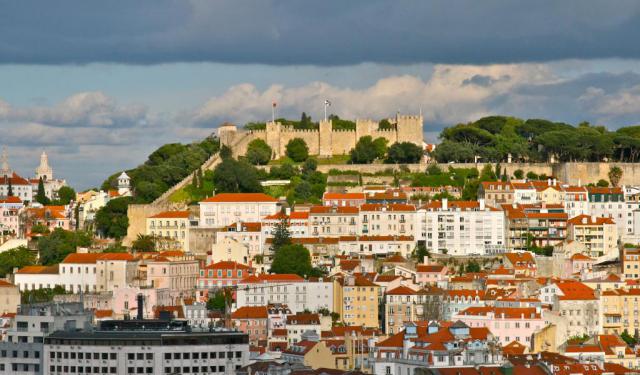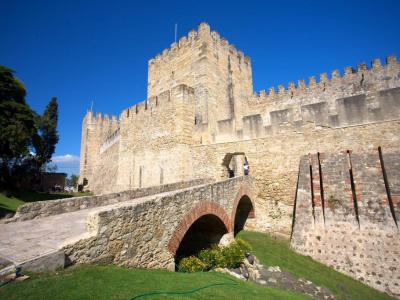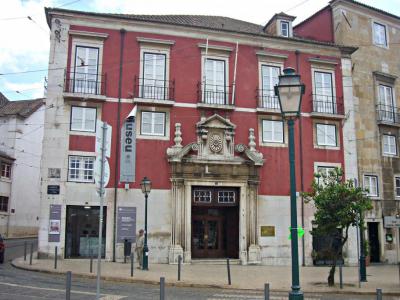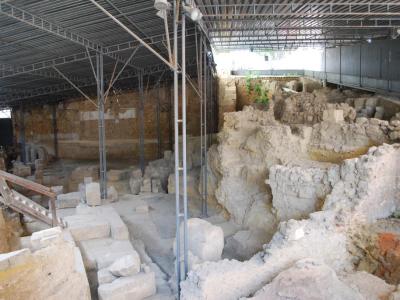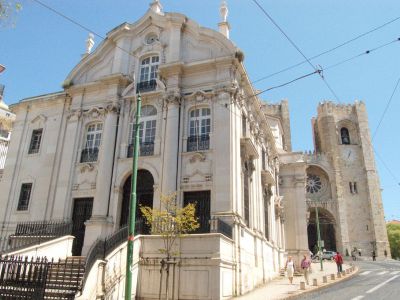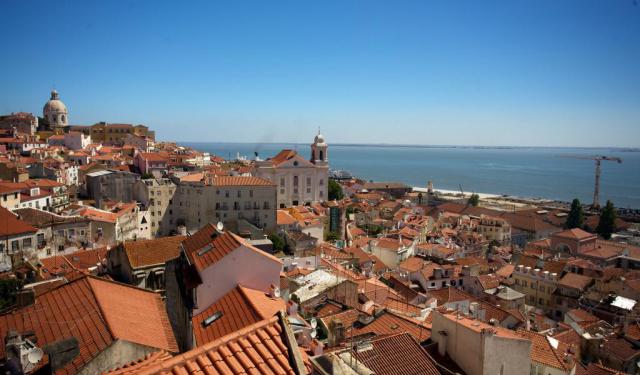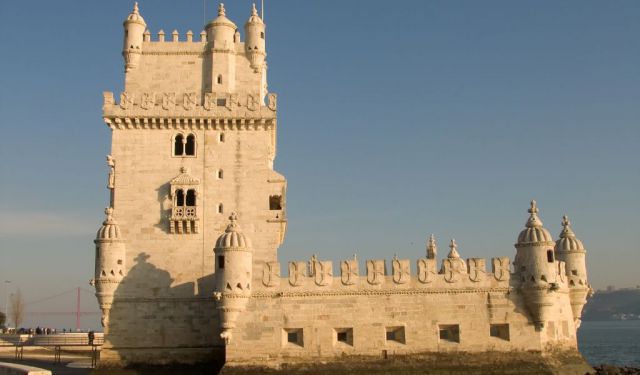Sao Jorge Castle to Lisbon Cathedral Walking Tour (Self Guided), Lisbon
Spreading on the slope between Saint George's Castle (Castelo de Sao Jorge) and the Tagus River, the oldest neighborhood of the Portuguese capital, Alfama, captivates visitors with its rich cultural heritage and picturesque ambiance. The area is home to numerous historical attractions and as such makes a perfect destination for a classic Lisbon walk!
Perhaps the best starting point for it is the Castle of Saint George, an iconic medieval fortress perched atop one of Lisbon's hills – a definite must-visit spot!
Rolling downhill we arrive at the Museum of Portuguese Decorative Arts (Museu de Artes Decorativas Portuguesas), showcasing exquisite Portuguese craftsmanship, including ceramics, textiles, and furniture, providing insight into the country's artistic traditions.
For stunning vistas of Lisbon, head to the Sun Gates Viewpoint (Miradouro das Portas do Sol) and the Saint Lucia Viewpoint (Miradouro de Santa Luzia). The two offer a serene escape where you can appreciate the city's beauty while savoring the Portuguese sunshine.
History enthusiasts will be drawn to the Ancient Roman Theatre Museum (Teatro Romano de Lisboa) showcasing the remains of a Roman theater dating back to the 1st century BC.
Amidst this historical backdrop, you'll find the Cathedral of Saint Mary Major (Santa Maria Maior), an imposing church with Moorish elements. The nearby Saint Anthony's Church (Igreja de Santo Antonio de Lisboa) is dedicated to the city's patron saint.
Visiting Alfama, with its narrow alleys, colorful facades, and the sound of traditional Fado music filling the air, is an adventure in its own right. Without having explored it on foot, you can hardly immerse yourself in Lisbon's cultural tapestry. So, plan your journey to Alfama today, and discover the captivating blend of history, art, and breathtaking views that await you in this enchanting district.
Perhaps the best starting point for it is the Castle of Saint George, an iconic medieval fortress perched atop one of Lisbon's hills – a definite must-visit spot!
Rolling downhill we arrive at the Museum of Portuguese Decorative Arts (Museu de Artes Decorativas Portuguesas), showcasing exquisite Portuguese craftsmanship, including ceramics, textiles, and furniture, providing insight into the country's artistic traditions.
For stunning vistas of Lisbon, head to the Sun Gates Viewpoint (Miradouro das Portas do Sol) and the Saint Lucia Viewpoint (Miradouro de Santa Luzia). The two offer a serene escape where you can appreciate the city's beauty while savoring the Portuguese sunshine.
History enthusiasts will be drawn to the Ancient Roman Theatre Museum (Teatro Romano de Lisboa) showcasing the remains of a Roman theater dating back to the 1st century BC.
Amidst this historical backdrop, you'll find the Cathedral of Saint Mary Major (Santa Maria Maior), an imposing church with Moorish elements. The nearby Saint Anthony's Church (Igreja de Santo Antonio de Lisboa) is dedicated to the city's patron saint.
Visiting Alfama, with its narrow alleys, colorful facades, and the sound of traditional Fado music filling the air, is an adventure in its own right. Without having explored it on foot, you can hardly immerse yourself in Lisbon's cultural tapestry. So, plan your journey to Alfama today, and discover the captivating blend of history, art, and breathtaking views that await you in this enchanting district.
How it works: Download the app "GPSmyCity: Walks in 1K+ Cities" from Apple App Store or Google Play Store to your mobile phone or tablet. The app turns your mobile device into a personal tour guide and its built-in GPS navigation functions guide you from one tour stop to next. The app works offline, so no data plan is needed when traveling abroad.
Sao Jorge Castle to Lisbon Cathedral Walking Tour Map
Guide Name: Sao Jorge Castle to Lisbon Cathedral Walking Tour
Guide Location: Portugal » Lisbon (See other walking tours in Lisbon)
Guide Type: Self-guided Walking Tour (Sightseeing)
# of Attractions: 7
Tour Duration: 1 Hour(s)
Travel Distance: 1.1 Km or 0.7 Miles
Author: DanaOffice
Sight(s) Featured in This Guide:
Guide Location: Portugal » Lisbon (See other walking tours in Lisbon)
Guide Type: Self-guided Walking Tour (Sightseeing)
# of Attractions: 7
Tour Duration: 1 Hour(s)
Travel Distance: 1.1 Km or 0.7 Miles
Author: DanaOffice
Sight(s) Featured in This Guide:
- Castelo de Sao Jorge (Saint George's Castle)
- Museu de Artes Decorativas Portuguesas (Museum of Portuguese Decorative Arts)
- Miradouro das Portas do Sol (Gates of the Sun Viewpoint)
- Miradouro de Santa Luzia (Santa Luzia Viewpoint)
- Teatro Romano de Lisboa (Ancient Roman Theatre Museum)
- Santa Maria Maior (Cathedral of St. Mary Major)
- Igreja de Santo Antonio de Lisboa (St. Anthony's Church)
1) Castelo de Sao Jorge (Saint George's Castle) (must see)
Saint George’s Castle is a historic fortress in Lisbon’s Santa Maria Maior district. Its hilltop location has been occupied since the 8th century BC, with fortifications dating back to the 2nd century BC. Over time, the site reflected influences from the Celts, Phoenicians, Greeks, Carthaginians, Romans, Suebi, Visigoths, and Moors. The Berbers added the so-called “Moorish Encirclement” walls in the 10th century, and the Moors held the castle until the Christian Reconquista.
The castle played a pivotal role during the 1147 Siege of Lisbon when it was captured in a major Second Crusade victory. This fortified stronghold became a royal residence in 1255 and was named after Saint George in the 14th century by King John I to symbolize ties with England. In the later period, it served as a military barracks and home to Portugal’s National Archive. Although damaged in the 1755 earthquake, the 20th-century restorations regained its prominence as a national monument and cultural site.
Within this castle complex, you'll find medieval architecture with ten towers, a dry moat, and steep hillsides for natural defense. Highlights include the terraced Arms Square with cannons and a statue of Afonso Henriques, the first king of Portugal, and the Tower of Ulysses, which houses a camera obscura offering shows (every 20 minutes) in various languages, including English, Portuguese, and Spanish. The citadel's primary entrance features a 19th-century gate adorned with Portugal's coat of arms, Queen Maria II's name, and the date 1846.
Inside, visitors can enjoy a range of amenities, including restaurants, cafes, a wine bar, an ice cream stand, and public restrooms. Peacocks roam freely throughout the grounds, particularly in one of the primary dining areas. While dining within the castle walls may be slightly pricier than in the surrounding areas, it is not excessively so. Alternatively, you have the option of bringing your own food and beverages. Admission is reasonably priced and children enter for free.
Saint George’s Castle also includes the ruins of a royal palace, such as the Casa Ogival, which is now home to the Olissipónia multimedia exhibit detailing Lisbon’s history. Gardens and historical artifacts enhance the experience, making the castle a symbol of Lisbon’s rich past and an essential cultural landmark.
Tip:
Although the journey to the castle involves a steep uphill climb, it provides a delightful stroll through the narrow streets of historic Lisbon, with numerous opportunities to stop and savor local cuisine. Alternatively, you can take cable car #28 to admire the neighborhood's charming and diverse architecture, providing excellent photo opportunities.
The castle played a pivotal role during the 1147 Siege of Lisbon when it was captured in a major Second Crusade victory. This fortified stronghold became a royal residence in 1255 and was named after Saint George in the 14th century by King John I to symbolize ties with England. In the later period, it served as a military barracks and home to Portugal’s National Archive. Although damaged in the 1755 earthquake, the 20th-century restorations regained its prominence as a national monument and cultural site.
Within this castle complex, you'll find medieval architecture with ten towers, a dry moat, and steep hillsides for natural defense. Highlights include the terraced Arms Square with cannons and a statue of Afonso Henriques, the first king of Portugal, and the Tower of Ulysses, which houses a camera obscura offering shows (every 20 minutes) in various languages, including English, Portuguese, and Spanish. The citadel's primary entrance features a 19th-century gate adorned with Portugal's coat of arms, Queen Maria II's name, and the date 1846.
Inside, visitors can enjoy a range of amenities, including restaurants, cafes, a wine bar, an ice cream stand, and public restrooms. Peacocks roam freely throughout the grounds, particularly in one of the primary dining areas. While dining within the castle walls may be slightly pricier than in the surrounding areas, it is not excessively so. Alternatively, you have the option of bringing your own food and beverages. Admission is reasonably priced and children enter for free.
Saint George’s Castle also includes the ruins of a royal palace, such as the Casa Ogival, which is now home to the Olissipónia multimedia exhibit detailing Lisbon’s history. Gardens and historical artifacts enhance the experience, making the castle a symbol of Lisbon’s rich past and an essential cultural landmark.
Tip:
Although the journey to the castle involves a steep uphill climb, it provides a delightful stroll through the narrow streets of historic Lisbon, with numerous opportunities to stop and savor local cuisine. Alternatively, you can take cable car #28 to admire the neighborhood's charming and diverse architecture, providing excellent photo opportunities.
2) Museu de Artes Decorativas Portuguesas (Museum of Portuguese Decorative Arts)
Housed within a grand 17th-century palace that once served as the urban residence of the Count of Azurara, the Portuguese Decorative Arts Museum offers a captivating glimpse into the lifestyles of affluent Lisbon citizens during the 18th and 19th centuries. The palace's splendid interiors have retained their original 17th-century wooden floors, painted ceilings, and the distinctive 'azulejos', a characteristic form of Portuguese painted tin-glazed tile work. While some of the azulejos were an integral part of the palace's history, others were added during the building's restoration.
The museum thoughtfully presents an array of collections, including Indo-Portuguese, Portuguese, English, and French furniture, an extensive assortment of silver artifacts, faience tin-glazed pottery, authentic Chinese porcelain, Flemish tapestries dating from the 16th to the 18th centuries, an antique grandfather clock, and even a horse-drawn carriage. Among its treasures are unique items originating from nearly every country formerly under Portuguese colonial rule, showcasing remarkable pieces from regions like Goa, Brazil, Macao, and more. Ultimately, a visit here offers a profound and enduring appreciation for Portugal's distinctive aesthetic sensibility.
Tip:
In the vicinity of this spot, you'll find two lookout points (Miradouro das Portas do Sol / Miradouro de Santa Luzia) that offer stunning vistas, perfect for capturing memorable photographs.
The museum thoughtfully presents an array of collections, including Indo-Portuguese, Portuguese, English, and French furniture, an extensive assortment of silver artifacts, faience tin-glazed pottery, authentic Chinese porcelain, Flemish tapestries dating from the 16th to the 18th centuries, an antique grandfather clock, and even a horse-drawn carriage. Among its treasures are unique items originating from nearly every country formerly under Portuguese colonial rule, showcasing remarkable pieces from regions like Goa, Brazil, Macao, and more. Ultimately, a visit here offers a profound and enduring appreciation for Portugal's distinctive aesthetic sensibility.
Tip:
In the vicinity of this spot, you'll find two lookout points (Miradouro das Portas do Sol / Miradouro de Santa Luzia) that offer stunning vistas, perfect for capturing memorable photographs.
3) Miradouro das Portas do Sol (Gates of the Sun Viewpoint)
The Gates of the Sun viewpoint, akin to a home’s balcony, sits above the ancient neighborhood Alfama. Just steps away from the Santa Luzia viewpoint, it offers stunning views across Alfama and the Tagus River. The layout of Alfama unfolds below in a picturesque maze of streets, stairways, and alleys, all visible from this panoramic balcony.
Visitors to the Gates of the Sun viewpoint can indulge in authentic Portuguese coffee at the local kiosk, watch the iconic #28 electric tram pass by, and view the statue of Saint Vincent, the patron saint of Lisbon, symbolically holding a boat flanked by two ravens, representing the city. Additionally, from this point, one can see the Church of Saint Vincent and the expanse of the Alfama neighborhood stretching to the Tagus River.
Installed in 1949, a statue of Saint Vincent enhances the cultural significance of the viewpoint. The location is also prime for photographers, who find the backdrop of the Decorative Arts Museum and the panoramic view from Saint Vincent de Fora Monastery to the waterfront irresistibly photogenic.
Tip:
For a unique and enjoyable experience, seek out a flight of stairs and follow the WC (restroom) sign. Descend the stairs and pass under an arch to discover a mural depicting Lisbon's history in a comic-book style.
The view surprises at dusk, when the sun goes down and the colors of Lisbon’s architecture turn another shade.
Visitors to the Gates of the Sun viewpoint can indulge in authentic Portuguese coffee at the local kiosk, watch the iconic #28 electric tram pass by, and view the statue of Saint Vincent, the patron saint of Lisbon, symbolically holding a boat flanked by two ravens, representing the city. Additionally, from this point, one can see the Church of Saint Vincent and the expanse of the Alfama neighborhood stretching to the Tagus River.
Installed in 1949, a statue of Saint Vincent enhances the cultural significance of the viewpoint. The location is also prime for photographers, who find the backdrop of the Decorative Arts Museum and the panoramic view from Saint Vincent de Fora Monastery to the waterfront irresistibly photogenic.
Tip:
For a unique and enjoyable experience, seek out a flight of stairs and follow the WC (restroom) sign. Descend the stairs and pass under an arch to discover a mural depicting Lisbon's history in a comic-book style.
The view surprises at dusk, when the sun goes down and the colors of Lisbon’s architecture turn another shade.
4) Miradouro de Santa Luzia (Santa Luzia Viewpoint)
The Viewpoint de Santa Luzia in Lisbon presents a stunning overlook of the Alfama district and the Tagus River. From this vantage point, visitors can see significant landmarks such as the National Pantheon of Santa Engracia, the Church of Santo Estevao, and the spires of Sao Miguel Church. This viewpoint is noted for offering similarly picturesque, albeit slightly less commanding, views to those at the nearby Gates of the Sun viewpoint.
Encompassing the traditional tiled roofs and historical churches of Alfama stretching out towards the Tagus estuary, the view from Santa Luzia is enhanced with its inviting ambiance. This site features a beautifully landscaped garden on multiple levels, with azalea trees, ample seating under pergola-like structures, and walls adorned with traditional blue "azulejo" tiles. One particularly notable azulejo panel illustrates the "Reconquista"-the historical liberation of the Iberian Peninsula from Moorish rule in 1147-which is displayed on the exterior wall of the adjacent Santa Luzia church.
Dating back to the 12th century, this church was largely rebuilt after the devastating 1755 earthquake. Despite its unassuming exterior, it has a cross-shaped layout and a richly decorated Baroque interior. Its façade is highlighted with azulejo tiles that depict important moments of the Portuguese past. Another azulejo mural depicts Commerce Square before it was destroyed in the 1755 earthquake, offering a historical snapshot to visitors.
Conveniently, the Santa Luzia and Gates of the Sun viewpoints are just a short walk from each other, allowing visitors to enjoy both spots in a single trip. The area also includes a small café and restrooms. The latter are found nearby, after a short ascent up the hill, around the corner from the church, and down a set of steps.
Tip:
Visiting the Santa Luzia Viewpoint is recommended either early in the morning or late in the afternoon to catch the exquisite sunrises or sunsets. Summers tend to be crowded and hot, so preparing for high temperatures and sun exposure is crucial. Visiting outside the peak tourist season can offer a cooler and more tranquil experience.
Be sure to keep an eye out for the small market nearby, offering various cork products and textiles, often at more reasonable prices than elsewhere in the city, making it an excellent spot for picking up souvenirs.
Encompassing the traditional tiled roofs and historical churches of Alfama stretching out towards the Tagus estuary, the view from Santa Luzia is enhanced with its inviting ambiance. This site features a beautifully landscaped garden on multiple levels, with azalea trees, ample seating under pergola-like structures, and walls adorned with traditional blue "azulejo" tiles. One particularly notable azulejo panel illustrates the "Reconquista"-the historical liberation of the Iberian Peninsula from Moorish rule in 1147-which is displayed on the exterior wall of the adjacent Santa Luzia church.
Dating back to the 12th century, this church was largely rebuilt after the devastating 1755 earthquake. Despite its unassuming exterior, it has a cross-shaped layout and a richly decorated Baroque interior. Its façade is highlighted with azulejo tiles that depict important moments of the Portuguese past. Another azulejo mural depicts Commerce Square before it was destroyed in the 1755 earthquake, offering a historical snapshot to visitors.
Conveniently, the Santa Luzia and Gates of the Sun viewpoints are just a short walk from each other, allowing visitors to enjoy both spots in a single trip. The area also includes a small café and restrooms. The latter are found nearby, after a short ascent up the hill, around the corner from the church, and down a set of steps.
Tip:
Visiting the Santa Luzia Viewpoint is recommended either early in the morning or late in the afternoon to catch the exquisite sunrises or sunsets. Summers tend to be crowded and hot, so preparing for high temperatures and sun exposure is crucial. Visiting outside the peak tourist season can offer a cooler and more tranquil experience.
Be sure to keep an eye out for the small market nearby, offering various cork products and textiles, often at more reasonable prices than elsewhere in the city, making it an excellent spot for picking up souvenirs.
5) Teatro Romano de Lisboa (Ancient Roman Theatre Museum)
The Romans, they seem to have left their mark everywhere! Roman theaters, in a broader sense, serve as symbols of power and bear witness to the process of Romanization. This holds true for the Felicitas Iulia Olisipo theater, the name associated with the city of Lisbon during the Roman era. As theaters began to encompass both political and religious roles, particularly during the reign of Emperor Augustus, they became primary locations for the Imperial cult.
The Roman Theater of Olisipo was of considerable size, seating ~4,000 spectators; however, during the Middle Ages, it gradually vanished beneath the earth's surface due to neglect, natural forces like wind, and soil erosion. It was only after the 1755 earthquake that sections of it reemerged, rekindling interest in Lisbon's Roman history. Subsequent excavations unearthed a treasure trove of artifacts that now comprise the museum's permanent displays. Among these discoveries are numerous columns, stone statues, and a modest collection of archaeological finds.
The museum's most captivating feature for visitors is the installation of multimedia presentations and touch screens, which vividly recount the story of Lisbon during the Roman period. Although relatively compact and possessing a smaller collection compared to other Roman archaeological museums in Europe, the museum is thoughtfully organized and presented through these interactive displays. So, take your time and explore at your leisure!
The Roman Theater of Olisipo was of considerable size, seating ~4,000 spectators; however, during the Middle Ages, it gradually vanished beneath the earth's surface due to neglect, natural forces like wind, and soil erosion. It was only after the 1755 earthquake that sections of it reemerged, rekindling interest in Lisbon's Roman history. Subsequent excavations unearthed a treasure trove of artifacts that now comprise the museum's permanent displays. Among these discoveries are numerous columns, stone statues, and a modest collection of archaeological finds.
The museum's most captivating feature for visitors is the installation of multimedia presentations and touch screens, which vividly recount the story of Lisbon during the Roman period. Although relatively compact and possessing a smaller collection compared to other Roman archaeological museums in Europe, the museum is thoughtfully organized and presented through these interactive displays. So, take your time and explore at your leisure!
6) Santa Maria Maior (Cathedral of St. Mary Major)
The Cathedral of Saint Mary Major, often called Lisbon Cathedral or simply the Sé, is a Roman Catholic cathedral and the oldest church in the city. Built in 1147, it has survived many earthquakes and been modified, renovated, and restored numerous times, resulting in a mix of different architectural styles. The seat of the Patriarchate of Lisbon, it has been classified as a National Monument since 1910.
The first cathedral in Lisbon was constructed on the site of the former Moorish mosque shortly after the Second Crusade led by King Afonso Henriquez in the mid-1100s. During this pivotal period, the relics of Saint Vincent of Saragossa, the city's patron saint, were transported from Southern Portugal and enshrined here, remaining undisturbed ever since. Recent excavations in the cathedral's cloister have uncovered Roman, Visigothic, and medieval remains, emphasizing the site's historical layers.
Lisbon Cathedral, a fortress-like structure with a Latin cross layout, maintains its Romanesque roots from the 12th century. The cathedral's robust façade features two towers and crenellations, a design typical of Portuguese cathedrals from the Reconquista era, indicating its historical military significance. The interior preserves the original west façade with a rose window, Romanesque portals, and barrel vaulting.
Transitioning to Gothic architecture in the late 13th century under King Dinis, the cathedral saw the addition of a Gothic cloister, although much of it was later damaged by the 1755 earthquake. Noteworthy Gothic elements include the ambulatory with its radiating chapels and ribbed vaulting, enhancing the structure with ample light and housing significant tombs from the mid-14th century.
The cathedral also hosted the Saint Vincent Panels until the 17th century. The 18th century brought neoclassical and Rococo refurbishments post-earthquake, with significant contributions from the renowned local sculptor Machado de Castro.
Efforts in the 20th century aimed to restore the cathedral's medieval character by removing neoclassical elements. This renovation imbued the structure with a predominantly medieval aesthetic, characterized by robust stone walls and fortress-like towers.
Notable among its chapels is the Chapel of Saint Ildefonso, housing a carved sculpture of one of the first Portuguese Ambassadors, Lopo Pacheco, depicted with a loyal dog at his side. Additionally, the Cathedral includes a chapel dedicated to Saint Anthony of Padua, a celebrated figure born in Lisbon.
Tip:
Admission to the Cathedral is free. For a modest fee, between 10 am and 5 pm, you can also ascend partway up the tower to the Treasury. Please note that it is closed on Sundays.
The first cathedral in Lisbon was constructed on the site of the former Moorish mosque shortly after the Second Crusade led by King Afonso Henriquez in the mid-1100s. During this pivotal period, the relics of Saint Vincent of Saragossa, the city's patron saint, were transported from Southern Portugal and enshrined here, remaining undisturbed ever since. Recent excavations in the cathedral's cloister have uncovered Roman, Visigothic, and medieval remains, emphasizing the site's historical layers.
Lisbon Cathedral, a fortress-like structure with a Latin cross layout, maintains its Romanesque roots from the 12th century. The cathedral's robust façade features two towers and crenellations, a design typical of Portuguese cathedrals from the Reconquista era, indicating its historical military significance. The interior preserves the original west façade with a rose window, Romanesque portals, and barrel vaulting.
Transitioning to Gothic architecture in the late 13th century under King Dinis, the cathedral saw the addition of a Gothic cloister, although much of it was later damaged by the 1755 earthquake. Noteworthy Gothic elements include the ambulatory with its radiating chapels and ribbed vaulting, enhancing the structure with ample light and housing significant tombs from the mid-14th century.
The cathedral also hosted the Saint Vincent Panels until the 17th century. The 18th century brought neoclassical and Rococo refurbishments post-earthquake, with significant contributions from the renowned local sculptor Machado de Castro.
Efforts in the 20th century aimed to restore the cathedral's medieval character by removing neoclassical elements. This renovation imbued the structure with a predominantly medieval aesthetic, characterized by robust stone walls and fortress-like towers.
Notable among its chapels is the Chapel of Saint Ildefonso, housing a carved sculpture of one of the first Portuguese Ambassadors, Lopo Pacheco, depicted with a loyal dog at his side. Additionally, the Cathedral includes a chapel dedicated to Saint Anthony of Padua, a celebrated figure born in Lisbon.
Tip:
Admission to the Cathedral is free. For a modest fee, between 10 am and 5 pm, you can also ascend partway up the tower to the Treasury. Please note that it is closed on Sundays.
7) Igreja de Santo Antonio de Lisboa (St. Anthony's Church)
The Church of Saint Anthony of Lisbon, a Roman Catholic church, is a tribute to Saint Anthony of Lisbon, also known as Saint Anthony of Padua. It is famously located at the site where the saint was born in 1195 and has been designated a National Monument. The church's origins trace back to a 15th-century chapel built over Saint Anthony's family home, near the Lisbon Cathedral. This structure underwent several reconstructions, the most notable being during King Manuel I's reign, in the early 16th century, and later, in the 18th century, under King John V.
The 1755 Lisbon earthquake devastated the church, leaving only the main chapel intact. It was subsequently rebuilt in a Baroque-Rococo style post-1767. Unique funding efforts for the rebuild included collections from the city’s children who asked for "a small coin for Saint Anthony." The tradition of venerating Saint Anthony continues robustly with crafted thrones and altars in his honor during Lisbon’s popular June festivities, dedicated to him.
Saint Anthony is deeply revered in Lisbon, not only as the patron saint but also as a matchmaker. Traditionally, couples visit the church on their wedding day to seek blessings for their marriage. Each year on June 13, Saint Anthony's feast day, a procession significant to the city’s cultural and religious calendar, starts from this church, passing the Lisbon Cathedral, and meandering through the Alfama neighborhood.
Pope John Paul II visited the church on May 12, 1982. He inaugurated a statue of Saint Anthony and prayed in the crypt-the only part of the church dating back to 1195-where a tile panel commemorates his visit. The crypt marks the spot where the saint was born and is a poignant site for pilgrims and visitors.
Tip:
Adjacent to the church, you'll find a small museum housing paintings, sculptures, and manuscripts associated with Saint Anthony. Museum admission is fairly cheap, with free entry on Sundays until 2 pm and when using the Lisboa Card. If you have a penchant for acquiring religious souvenirs during your travels, you'll discover a selection of medals, statues, and other items available at the church as well.
The 1755 Lisbon earthquake devastated the church, leaving only the main chapel intact. It was subsequently rebuilt in a Baroque-Rococo style post-1767. Unique funding efforts for the rebuild included collections from the city’s children who asked for "a small coin for Saint Anthony." The tradition of venerating Saint Anthony continues robustly with crafted thrones and altars in his honor during Lisbon’s popular June festivities, dedicated to him.
Saint Anthony is deeply revered in Lisbon, not only as the patron saint but also as a matchmaker. Traditionally, couples visit the church on their wedding day to seek blessings for their marriage. Each year on June 13, Saint Anthony's feast day, a procession significant to the city’s cultural and religious calendar, starts from this church, passing the Lisbon Cathedral, and meandering through the Alfama neighborhood.
Pope John Paul II visited the church on May 12, 1982. He inaugurated a statue of Saint Anthony and prayed in the crypt-the only part of the church dating back to 1195-where a tile panel commemorates his visit. The crypt marks the spot where the saint was born and is a poignant site for pilgrims and visitors.
Tip:
Adjacent to the church, you'll find a small museum housing paintings, sculptures, and manuscripts associated with Saint Anthony. Museum admission is fairly cheap, with free entry on Sundays until 2 pm and when using the Lisboa Card. If you have a penchant for acquiring religious souvenirs during your travels, you'll discover a selection of medals, statues, and other items available at the church as well.
Walking Tours in Lisbon, Portugal
Create Your Own Walk in Lisbon
Creating your own self-guided walk in Lisbon is easy and fun. Choose the city attractions that you want to see and a walk route map will be created just for you. You can even set your hotel as the start point of the walk.
Alfama Walking Tour
Alfama, the oldest district of Lisbon, spreads downhill along the Tagus River. It retains a charmingly labyrinthine layout with narrow alleys and steep streets. Under Islamic rule, this part of the city was increasingly inhabited by fishermen and the poor. The reputation of being a poor area still lives on. The name Alfama derives from the Arabic al-ḥamma, which means "hot fountains"... view more
Tour Duration: 2 Hour(s)
Travel Distance: 3.0 Km or 1.9 Miles
Tour Duration: 2 Hour(s)
Travel Distance: 3.0 Km or 1.9 Miles
Lisbon Introduction Walking Tour
Lisbon, the capital city of Portugal, is a fascinating blend of history, culture, and breathtaking viewpoints. Its name is believed to have originated from the Phoenician term "Allis Ubbo", which means "safe harbor," reflecting the city's importance as a maritime hub since ancient times. Nestled at Europe's western edge and abundant in architectural styles, Lisbon... view more
Tour Duration: 2 Hour(s)
Travel Distance: 2.4 Km or 1.5 Miles
Tour Duration: 2 Hour(s)
Travel Distance: 2.4 Km or 1.5 Miles
Belem Walking Tour
Also known as Santa Maria de Belem, the district of Belem is one of the most visited in Lisbon. Situated not far from the city center, it lines the Tagus River and is the original location of Lisbon's port – the starting point of the many great voyages of discovery by Portuguese explorers, such as Vasco da Gama – departed from here for India in 1497, and Pedro Alvares Cabral – for... view more
Tour Duration: 2 Hour(s)
Travel Distance: 3.0 Km or 1.9 Miles
Tour Duration: 2 Hour(s)
Travel Distance: 3.0 Km or 1.9 Miles
Useful Travel Guides for Planning Your Trip
17 Uniquely Portuguese Things to Buy in Lisbon
Formerly a major colonial power, Portugal has accumulated great knowledge in craftsmanship. While in Lisbon, you can treat yourself to a vast variety of quality things: wines, ceramics, jewellery, leather goods, books and many more. Most shops in Lisbon open at 9 or 10am, and close in the evening at...
Top 8 Cafes and Restaurants in Lisbon
Experience Lisbon as a local by enjoying typical Portuguese dishes at the best restaurants throughout the city at a price you can afford. Take away the overwhelming pressure of deciding where to eat in a city as dynamic and riveting as Lisbon by allowing this guide to suggest local restaurants with...
The Most Popular Cities
/ view all
